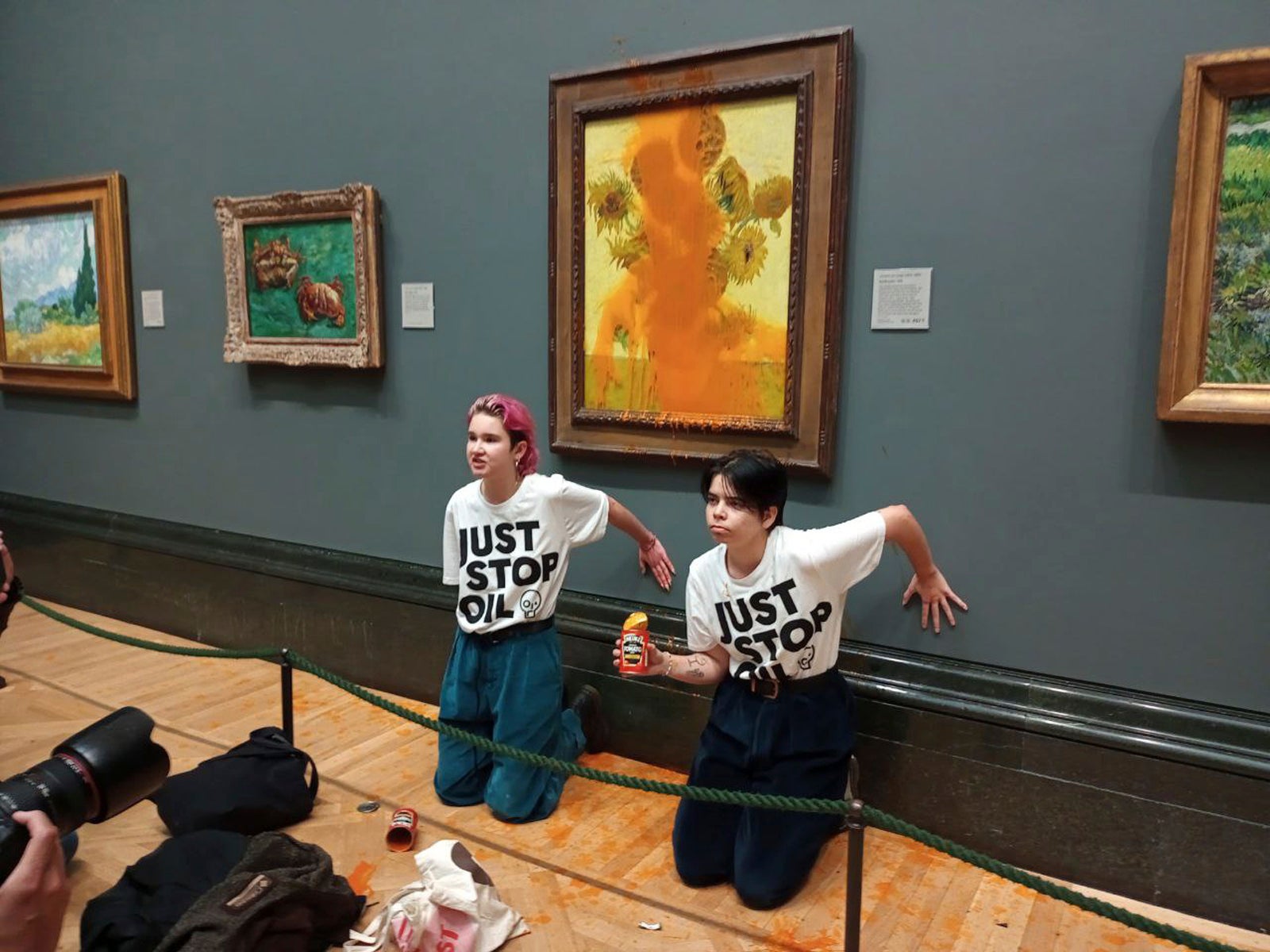Climate protesters hit Van Gogh’s Sunflowers with soup. Were they right?
The beloved painting, which art experts claim was also Van Gogh’s favourite, was hit with tomato soup on Friday to highlight the need to end oil and gas. It has provoked mixed reactions from the climate community, Louise Boyle finds


Your support helps us to tell the story
From reproductive rights to climate change to Big Tech, The Independent is on the ground when the story is developing. Whether it's investigating the financials of Elon Musk's pro-Trump PAC or producing our latest documentary, 'The A Word', which shines a light on the American women fighting for reproductive rights, we know how important it is to parse out the facts from the messaging.
At such a critical moment in US history, we need reporters on the ground. Your donation allows us to keep sending journalists to speak to both sides of the story.
The Independent is trusted by Americans across the entire political spectrum. And unlike many other quality news outlets, we choose not to lock Americans out of our reporting and analysis with paywalls. We believe quality journalism should be available to everyone, paid for by those who can afford it.
Your support makes all the difference.On Friday morning, Vincent Van Gogh’s masterpiece Sunflowers took a square hit from the contents of a couple of cans of tomato soup at the National Gallery in London.
It was the latest protest from Just Stop Oil, a climate activism coalition, during two weeks of civil resistance across London. The disruptions, which also saw the group spray paint at New Scotland Yard, are in response to the UK government’s failure to tackle the cost of living crisis and the climate crisis, the group said.
They have demanded a stop to new oil and gas licences recently put up for grabs by the UK government – even as climate scientists warn such licences will contribute to yet more emissions which are driving up global temperatures.
At around 11am, two young women wearing “Just Stop Oil” t-shirts entered the gallery room and splashed the Heinz soup cans, one of Andy Warhol’s favourite subjects.
“What is worth more, art or life? Is it worth more than food? More than justice? Are you more concerned about the protection of a painting, or the protection of our planet and people?” shouted activist Phoebe Plummer, aged 21, as they glued their hands to the wall.
She added: “The cost of living crisis is part of the cost of oil crisis. Fuel is unaffordable to millions of cold, hungry families. They can’t even afford to heat a tin of soup.”
The protesters were later arrested for criminal damage and aggravated trespass.
The oil painting, valued at $81m ( £72.5m), is protected by a glass cover and was unharmed, a National Gallery spokesperson told The Independent. Just Stop Oil also said that they were aware that the artwork, completed in 1888, was protected by glass.
About six hours after the soup was thrown, the painting had been cleaned and was back on the gallery wall, the BBC reported.
Over the past 100 years, non-violent direct actions, some involving prestigious works of art, have been used in protests to drive societal change.
“Recently we’ve seen an increase in non-violent direct action, including road stoppages and some limited attacks on property. There is a long history of this kind of protest, including attacks on paintings at the National Gallery in London,” Amy Woodson-Boulton, professor of history at Loyola Marymount University in Los Angeles, who specialises in the history of Britain, Ireland and the British Empire, told The Independent, in an email.
“Women in the UK demanding the right to vote, for example, attacked paintings in Manchester and one, Mary Richardson, slashed Diego Velasquez’s painting The Toilet of Venus in 1914 – in both cases to protest the jailing of the leader of the Women’s Social and Political Union, Emmeline Pankhurst.”
For Professor Woodson-Boulton, targeting precious art raises questions about how society processes the existential threat of the climate crisis.
“The question that such attacks pose for us is, what is the value of this object? How can we understand our anger at the temporary defacement of objects we hold beyond price in relation to the mass extinction and suffering of climate change?
“That is, acts like this may be controversial, as they were at the time. But they are important acts of civil resistance that force the public to consider why we are allowing the wealthiest governments, often controlled by corporate interests, to ignore the science that we need to end our dependence on fossil fuels, we need to protect the most vulnerable, and we need to address the fact that those least responsible for climate change are already feeling its worst effects.”
She added: “To that extent, these protestors are working in an important tradition of non-violent protest (protest that does not harm other people) and raising the most important questions facing humanity.”
The image of the orangey-red liquid dripping down one of the world’s most iconic images – and the painting that Van Gogh himself was most proud of – provoked visceral reactions.
For some, the protest symbolised the growing divide between young people, facing an uncertain future on an overheating planet, and the apathy of political and financial elites who hold the reins in making large-scale shifts across sectors to cut emissions.
“Probably the only straightforward thing about Van Gogh was what he thought painting was for (‘to teach us to see’). So this is entirely appropriate, I think. Shameful that kids are pushed to this,” tweeted the comedian and writer, Frankie Boyle.
“If you are more upset by the left hand side than the right hand side, you might want to rethink your priorities a tad. Just a thought,” wrote Julia K Steinberger, a social ecology and ecological economics professor at the University of Lausanne, She shared a splitscreen of the activists throwing soup and a piece of the latest UN climate assessment which read: “Any further delay in concerted anticipatory global action on adaptation and mitigation will miss a brief and rapidly closing window of opportunity.”
The Van Gogh attack drew inevitable right-wing outrage which has remained on a constant boil over activists’ differing attempts to draw attention to the climate crisis in the past year.
But there was also concern on Friday among some climate scientists and activists that targeting a beloved artwork risked undermining the message.
“No matter the motive, damaging or destroying shared cultural treasures in the name of saving the planet is a mistake,” tweeted Dr Jonathan Foley, a climate and environmental scientist who leads the climate solutions group, Project Drawdown.
“As a researcher working on climate change, this shock action makes me very upset, because it is likely to antagonize public support for climate action. Damaging art to save life makes no sense. Fossil fuels are the problem, and art is part of the solution,” wrote Francois Gemenne, an expert on climate change and migration, and a lead author on the UN’s Intergovernmental Panel on Climate Change.
The attack was seen by some as a tiresome attempt at a shock tactic, after many protests centred around artworks in the past year. Others viewed it as having missed the point entirely.
“If you’re gonna have a climate protest at a museum, I feel like it ought to be about returning stolen art/artifacts to colonised nations and pointing out the connections between climate change and colonialism, not... this...” Mary Annaïse Heglar, a writer and podcaster whose work focuses on climate justice, tweeted.
In July, Just Stop Oil protesters glued themselves to a reproduction of Leonardo da Vinci’s The Last Supper at the Royal Academy, and John Constable’s The Hay Wain at the National Gallery. In May, a protester threw cake at the Mona Lisa in the Louvre, Paris.
Alex De Koning, a spokesperson for Just Stop Oil, told The Guardian on Friday that the group was concerned about alienating people from their cause – but that such actions were necessary to make change happen.
“But this is not The X Factor,” he told the newspaper. “We are not trying to make friends here, we are trying to make change, and unfortunately this is the way that change happens.”



Join our commenting forum
Join thought-provoking conversations, follow other Independent readers and see their replies
Comments